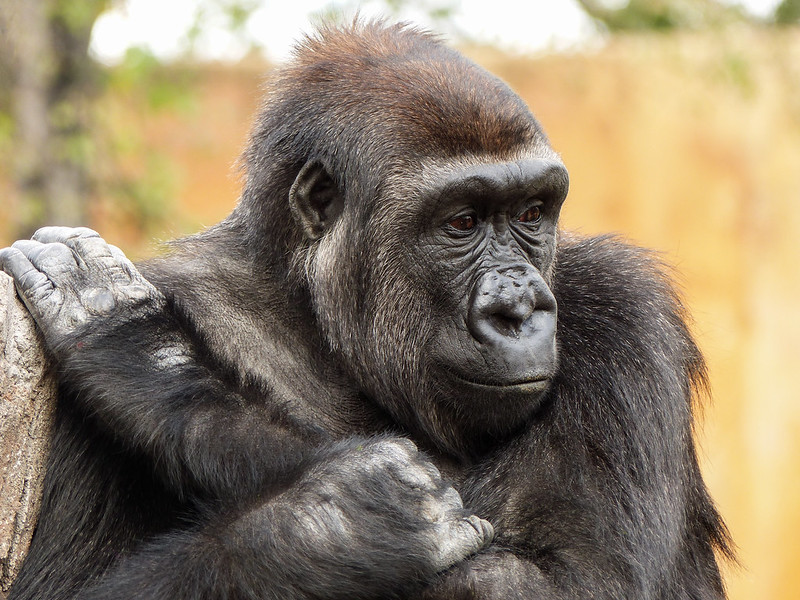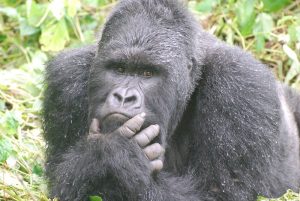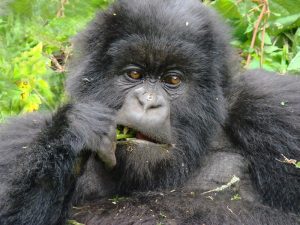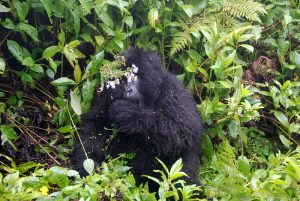Gorilla Species in Africa
Gorillas, the largest of the great apes, share 98% of their genetic code with humans, making them one of our closest relatives alongside bonobos and chimpanzees. Displaying a wide range of emotions similar to humans, such as sadness and laughter, gorillas inhabit various habitats in Africa, including tropical forests, wetlands, marshes, highlands, and mountains. Gorilla Species in Africa
Physical Characteristics
Gorillas possess powerful bodies with muscular arms, thick chests, large nostrils, and black/brownish hair covering their entire bodies except for specific areas like the face, hands, feet, and chests of older silverbacks. While predominantly walking on all fours, they can stand erect, particularly when feeding on tree bark or asserting dominance. Adult males, known as silverbacks due to the silver/gray hairs on their backs, outweigh females, with weights ranging from 135 to 220 kilograms in the wild. Those in captivity may grow heavier due to limited exercise opportunities. Young gorillas typically handle climbing and resting on short tree branches.
Social Structure and Behavior
Gorillas organize into groups led by a dominant silverback, occasionally with two related silverbacks leading. Group sizes vary from 4 to 30 individuals, comprising younger males, juveniles, females, and their offspring, with group stability primarily reliant on the bond between females and the dominant silverback. Mating, often initiated by females upon reaching fertility, leads to young females leaving their groups to avoid inbreeding and competition for the dominant silverback’s attention. Mature males may remain with their birth groups but are typically driven away by the dominant silverback, leading solitary lives or joining other bachelor males.
Comparison with Chimpanzees
Though chimpanzees are often considered more intelligent, gorillas exhibit calmer, more peaceful, and persistent behaviors, fostering stable group dynamics. Gorillas, albeit displaying a composed demeanor, emit a terrifying roar when threatened, with silverbacks employing aggressive displays to protect their families, including roaring, vegetation tearing, sideways running, ground slapping, and chest beating.
Feeding Habits and Habitat
Gorillas predominantly consume leaves, fruits, and shoots, occasionally supplementing their diet with ants or insects. With their substantial dietary needs, they traverse several kilometers daily in search of food. Despite not being territorial, gorilla groups generally avoid each other, with exceptions noted among western lowland gorillas, where group mingling and joint feeding occur.
Reproductive Cycle and Threats
Female gorillas reach sexual maturity around age 10, while males mature at approximately 15 years. They reproduce every four to five years, typically giving birth to single offspring, though twins are not uncommon. Threats to gorillas primarily stem from human activities such as habitat destruction, poaching, disease transmission, and accidental deaths from snares set for other forest animals.
Conservation Efforts
Various international wildlife organizations, individuals, and zoos collaborate to conserve gorilla populations through initiatives like gorilla tours, research, habitat protection, anti-poaching measures, and community sensitization programs. Despite these efforts, challenges such as civil unrest, corruption, and weak law enforcement persist, hindering conservation endeavors.
Types of Gorillas
Two Gorilla Species
Gorillas comprise two species: the Eastern gorilla and the Western gorilla (Gorilla Gorilla). Western gorillas, the most abundant species, exhibit distinct nose structures and lighter fur compared to Eastern gorillas. The Western gorilla further divides into two subspecies: the Cross River Gorilla (G. gorilla diehli) and the Western lowland gorilla (G. gorilla gorilla). Eastern gorillas consist of two subspecies: the mountain gorillas (G. beringei beringei) and the Grauer’s gorilla, formerly known as the Eastern lowland gorilla (G. beringei graueri).
Four Gorilla Sub-species
Western Lowland Gorillas
Residing in the lowland forests of central and west Africa, Western lowland gorillas represent the smallest yet most abundant subspecies, with an estimated population exceeding 350,000 individuals. Although commonly observed in zoos, their overall population has declined significantly due to human threats and the Ebola virus outbreak in 2003.
Cross River Gorilla
The critically endangered Cross River Gorilla inhabits forested mountains and highlands in Cameroon and Nigeria, with fewer than 350 individuals remaining. Threatened by habitat loss, poaching, and genetic isolation, concerted conservation efforts aim to safeguard this subspecies.
Grauer’s Gorilla or Eastern Lowland Gorilla
Found in the eastern Democratic Republic of Congo, the Grauer’s gorilla represents the largest subspecies, with approximately 7,500 individuals remaining in the wild. Habitat loss and poaching pose significant threats to their survival, emphasizing the importance of conservation measures.
Mountain Gorillas
Endemic to the Virunga Mountain regions of the Democratic Republic of Congo, Rwanda, and Uganda, mountain gorillas face habitat loss and human encroachment, with only around 1,000 individuals remaining in the wild. Conservation efforts focus on protecting their habitats and mitigating human-wildlife conflicts. Gorilla Species in Africa




